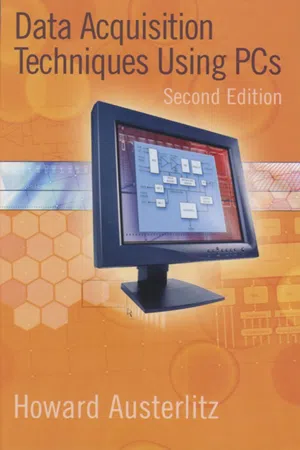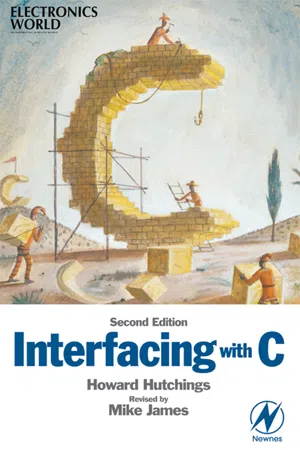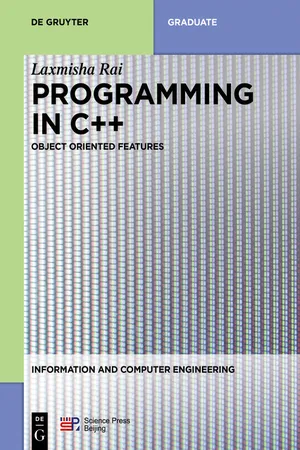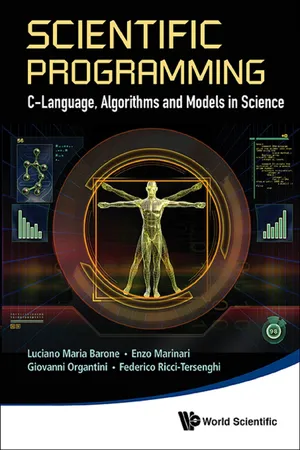Computer Science
C Plus Plus
C++ is a high-level programming language that is widely used in computer science. It is an extension of the C language and supports object-oriented programming, making it a versatile language for developing complex software applications. C++ is known for its efficiency, speed, and flexibility.
Written by Perlego with AI-assistance
Related key terms
5 Key excerpts on "C Plus Plus"
- eBook - ePub
- Howard Austerlitz(Author)
- 2002(Publication Date)
- Academic Press(Publisher)
The concept of object-oriented programming was developed to simplify the task of developing large, complex computer programs. It enables a programmer to break up a large problem into smaller, related sections. Then, each subsection of the problem can be translated into an object. An added benefit of object-oriented programming is that it encourages writing reusable code because of encapsulation and inheritance.You can use a C++ compiler with C code with few or no changes. Of course, the power of the new language is only apparent when you use the unique features of C++. If you are already familiar with C, you have to learn the new features and syntax of C++ along with its object-oriented philosophy. If we rewrote the main() section of our C averaging program in C++ we would see a new way of producing output:In this C++ example, cout is the standard output stream and << is the insertion operator. When you compare the cout statement here to the previous example using the printf statement, you will notice that there is no explicit formatting used to display the variable avg. Since the compiler knows that avg is a float, cout uses the correct format. This is an example of function overloading, an aspect of polymorphism. Note that endl (end line) is the same as the ‘\n’ character in C. Also note that in C++ comments begin with // and continue to the end of the line (for multiline comments, you can still use the C style /* */ comment delimiters).If you wanted to explicitly format an output variable in C++ you can use a manipulator with cout. For example, if you want to display an integer as hexadecimal instead of decimal:Here, the manipulator hex forces the output integer value to be displayed as a hexadecimal number. In a similar fashion, C++ uses a standard input stream to read in values from the keyboard, via cin:In this simple example, the variable val is assigned a value entered when the program runs. Note that the direction of the insertion operator (>>) indicates data flow—in this case from cin to val.The heart of C++ is defining classes and using them to create objects. Classes contain both private and public data (variables) and functions (subroutines). Keeping all data members (internal variables) private and only allowing member functions to be public (accessible by other parts of the program) is good practice for secure data encapsulation. Here is a simple C++ example of declaring a class and using an object: - eBook - ePub
- Howard Hutchings, Mike James(Authors)
- 2000(Publication Date)
- Newnes(Publisher)
1An introduction to C
C is a medium-level programming language developed by Dennis Ritchie of Bell Laboratories and implemented there on a PDP-11 in 1972. Historically, C was preceded by B, a language written by Ken Thompson in 1970 for the first UNIX system run on the PDP-7. B, in turn evolved from the Basic Cambridge Programming Language BCPL, developed by Martin Richards at Cambridge in 1967 as a systems programming language.The C Programming Language (1978), by Kernighan and Ritchie is the definitive text. Although it is not adopted as an international standard, it is generally accepted as standard C. This original and enigmatic text is not an introductory programming manual; it assumes familiarity with basic programming concepts such as variables, assignment statements, loops and functions – and is probably best read once you have mastered C. The increasing popularity of the language has encouraged numerous less esoteric works, many attempting to simplify the original Kernighan and Ritchie text. Each of these introductions has its relative merits; no doubt you will make your own choice and find what suits you best.In 1979, Bjarne Stoustrup added the concept of object-oriented classes to C. His first incarnation of this was called C with Classes and was the subject of a Bell laboratory report in 1980. By 1984, this had evolved into C++; a programming in-joke to reflect the C method of incrementing the value of a variable. Many compilers were available by 1987 when the language had attracted the attentions of the ISO and ANSI standardization committees.Properties and background
The versatility of C and C++ allows them to be run on the full range of processors; from 8-bit microcontrollers up to the Cray series of supercomputers. Designed to make programs fast and compact, this portable assembly language was used to program the remarkable computer-animated sequences in Return of the Jedi and Star Trek II. - eBook - ePub
Learn C Programming from Scratch
A step-by-step methodology with problem solving approach (English Edition)
- Mohammad Saleem Mir(Author)
- 2024(Publication Date)
- BPB Publications(Publisher)
This chapter aims to provide a comprehensive understanding of the C programming language, its components, and its practical applications. We will begin by exploring important facts about C and its relevance in modern programming. The chapter will then focus on Turbo C++, a popular development environment for Windows 10 and beyond, guiding setting up and utilizing this platform. We will dive into the fundamental components of C programs, including tokens, data types, variables, and literals. Additionally, we will examine the concept of storage classes and the wide range of operators available in C. With a strong foundation established, we will learn about input-output operations in C and provide hands-on experience by writing basic programs. By the end of this chapter, readers will have a solid understanding of C programming, enabling them to develop functional and efficient programs using the language.Facts about C The widely used programming language C has a long history and a wide range of capabilities. The following are some facts about C programming:- Dennis Ritchie at Bell Labs developed C in the early 1970s as a programming language for the Unix operating system.
- Since C is a compiled language, the source code is converted into machine code that a computer can use to run it.
- Thanks to its low-level capabilities, programmers may modify hardware and memory directly by writing code in high-level C.
- C is easy to learn and read because of its syntax and sparse use of keywords.
- Device drivers, operating systems, embedded systems, and other types of low-level software frequently employ C.
- A robust standard library for C, including functions for input/output, memory management, string manipulation, and other things.
- The object-oriented and structured programming paradigms are both supported in C.
- Due to its low-level features and standardized libraries, C programs may be very portable across several systems.
- C++, Java, and Python are just a few programming languages impacted by C.
- Despite its antiquity, C is still widely used today, and many software engineers believe it to be a crucial ability.
C was first employed for system development, including creating the operating system’s programs. Since C produces code that executes almost as quickly as code written in assembly language, it was adopted as a system development language. Several uses for C could include: - eBook - ePub
Programming in C++
Object Oriented Features
- Laxmisha Rai, Laxmisha Rai(Authors)
- 2019(Publication Date)
- De Gruyter(Publisher)
2 Introduction to Object-Oriented Programming and C++ Life is a series of natural and spontaneous changes. Don’t resist them – that only creates sorrow. Let reality be reality. Let things flow naturally forward in whatever way they like. ―Lao Tzu 2.1 Introduction In Chapter 1, we have studied about the basic concepts of computers and programming languages. There are many types of programming languages, such as procedural, functional, and object oriented. Our main purpose in this chapter is to understand the main features of OOP languages and the ways of compiling and running a C++ program successfully. In object-oriented programming, writing a program is easier and more convenient than many other types of programming languages. Today, an OOP language, such as C++, is popular and widely used to develop many software applications. However, the OOP is a new paradigm among programming languages. The basic concepts of an OOP language revolve around topics such as objects, classes, data abstraction, encapsulation, inheritance, polymorphism, and dynamic binding. In this chapter, we will focus on some of the basic concepts of object-oriented programming and how to write a simple C++ program. In addition, we will also present the steps to compile a program using freely available online compilers, Visual Studio, VC++ compiler, and CodeBlocks. 2.2 Object-oriented concepts Object-oriented programming has a number of advantages. It is simpler and easier to read and write programs. It can reuse the code more efficiently, and provide a robust and error-free code. In this section, we will try to understand various features of object-oriented programming languages briefly. Objects and classes In OOP, programs are written by using objects and classes. OOP concepts are different from other programming languages. All real-world objects are represented by objects. Every object has certain state and behavior. The state of the object is represented by variables and the behavior by methods - eBook - ePub
Scientific Programming: C-language, Algorithms And Models In Science
C-Language, Algorithms and Models in Science
- Luciano Maria Barone, Enzo Marinari, Giovanni Organtini, Federico Ricci Tersenghi(Authors)
- 2013(Publication Date)
- WSPC(Publisher)
C is a procedural language, not fully structured and typed. We already know what procedural means. A language is said to be structured if certain rules are obeyed when expressing the sequence of actions in the code. In Chapter 4 we discuss these rules for C in detail. In particular, structured programs do not allow to transfer the control of operations from one portion of code to another non-adjacent one by means of operations of the goto kind. C possesses a certain number of these statements allowing the execution flow to jump from one part to another. Therefore, it is not strictly structured. However, a program in C can always be rewritten without making use of these statements, resulting in a structured C program.C is a typed language. This means that all data need to be declared before they can be used in a program and this declaration should specify their type (integer, rational, string, etc.). Still, C is not considered a strongly typed language. Indeed, it is always possible to interpret a bit sequence corresponding to data of a certain type as if they belonged to another type. In C, errors due to bad programming can always be eliminated by using the methods of structured programming. However, it is not always possible to avoid the use of so-called type casting, i.e., the transformation of one type to another (Section 3.2).Nevertheless (and, in some cases, even thanks to this flexibility), C is quite adapted as a first language to learn the scientific programming methods. 2.8C compilers in their environmentThe operating system is a program that, when a computer is turned on, is loaded into its memory and immediately executed (bootstrapped in technical jargon). It takes care of the management of the computer resources (the CPU, the memory, the peripherals) and allows the programmer to interact with these by giving instructions (in the form of text, signs, sounds, etc.) without knowing the particular hardware structure of the machine or how the memory is organized15 .In theory, many different operating systems can be loaded on each CPU (not at the same time though). The most widespread ones are Microsoft® Windows® , Mac OS®
Learn about this page
Index pages curate the most relevant extracts from our library of academic textbooks. They’ve been created using an in-house natural language model (NLM), each adding context and meaning to key research topics.




